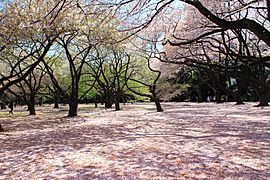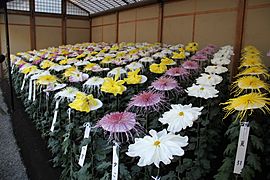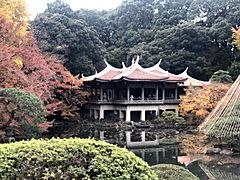Shinjuku Gyo-en facts for kids
Quick facts for kids Shinjuku Gyo-en |
|
|---|---|
| Shinjuku Gyo-en National Garden | |
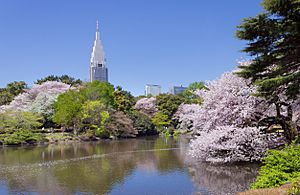 |
|
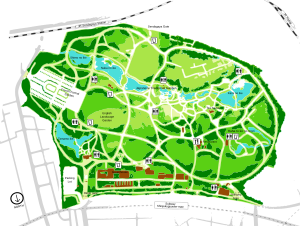
Map of the Shinjuku Gyo-en
|
|
| Type | National Park |
| Location | Shinjuku and Shibuya, Tokyo, Japan |
| Area | 58.3 ha (144 acres) |
| Operated by | Japanese Ministry of the Environment |
| Open | May 1906 |
| Status | Open |
| Plants |
|
Shinjuku Gyo-en (新宿御苑) is a very large park and garden in Shinjuku and Shibuya, two areas of Tokyo, Japan. It was once the home of a powerful family called Naitō during the Edo period (a time in Japanese history from 1603 to 1868). Later, it became a special garden managed by the Japanese Imperial Family. Today, it is a national park looked after by Japan's Ministry of the Environment.
Contents
History of Shinjuku Gyo-en
From Lord's Home to Imperial Garden
This land was given to Lord Naitō of Tsuruga by the shōgun, a military ruler of Japan, during the Edo period. Lord Naitō finished building a beautiful garden here in 1772. After the Meiji Restoration (a big change in Japan's government in 1868), the house and its land were used as a place to try out new farming methods.
It then became a garden for studying plants before becoming an imperial garden in 1879. The garden you see today was mostly finished in 1906. Sadly, much of the garden was destroyed by air raids in 1945 during World War II. But after the war, the garden was carefully rebuilt.
Becoming a National Park
In 1947, the control of imperial gardens, including this one, was moved to a government ministry. On May 21, 1949, Shinjuku Gyo-en opened to the public as a national park. In January 2001, it came under the care of the Ministry of the Environment. Its official English name became "Shinjuku Gyoen National Garden." The Japanese name, Shinjuku Gyoen, means "imperial garden."
In 1989, Shinjuku Gyoen was chosen for the funeral ceremonies of Emperor Shōwa. This happened before he was buried at the Musashi Imperial Graveyard.
What Makes Shinjuku Gyo-en Special
The garden is very big, covering 58.3 hectares (about 144 acres) with a path around it that is 3.5 kilometers long. It has three different garden styles mixed together. In the northern part, you'll find a French Formal style and an English Landscape style. To the south, there is a traditional Japanese style.
You can also find a traditional Japanese tea house inside the gardens. Shinjuku Gyoen is a very popular place for hanami, which is the Japanese tradition of viewing cherry blossoms. Many people visit during the cherry blossom season.
Amazing Plants and Trees
The garden is home to more than 20,000 trees. About 1,500 of these are cherry trees. They bloom at different times, from late March (like the Weeping Cherry) to early April (Tokyo Cherry), and even into late April (like the Kanzan Cherry).
Other impressive trees here include the tall Himalayan cedars. These trees stand much taller than the others in the park. You can also see tulip trees, cypresses, and plane trees. Plane trees were first planted in Japan right here in the Imperial Gardens.
The Shinjuku Gyo-en Greenhouse
Horticulture, which is the science of growing plants, has been happening in the garden's greenhouses since 1892. The current greenhouse, built in the 1950s, has over 1,700 kinds of tropical and subtropical plants. These plants are on display all the time for visitors to see.
Visiting Shinjuku Gyo-en
Entrances and Opening Hours
The garden has three main entrances: Shinjuku Gate, Okido Gate, and Sendagaya Gate. Shinjuku Gyoen is usually open from 9:00 AM to 5:30 PM from mid-March to the end of September. From October to mid-March, it closes earlier, at 4:00 PM. During July and late August, it stays open until 6:30 PM.
The garden is closed on Mondays. However, it stays open seven days a week during the popular cherry blossom season (late March to late April) and the chrysanthemum season (first half of November). If a Monday is a public holiday, the garden will be closed the next day instead. During cherry blossom season, you might need to book your visit in advance for some dates.
The greenhouse has slightly different hours. It is open from 9:30 AM to 5:00 PM from mid-March to the end of September. From October to mid-March, it closes at 3:30 PM. In July and late August, it is open until 6:00 PM.
How to Get There
Shinjuku Gyoen is easy to reach. It's a short walk from Shinjuku-gyoemmae Station on the Marunouchi Line. You can also walk from Sendagaya Station on the Chūō-Sōbu Line. The garden is also close to Shinjuku-sanchōme Station on the Tokyo Metro Fukutoshin Line. From exit C1 of that station, it's only about a four-minute walk.
Gallery



